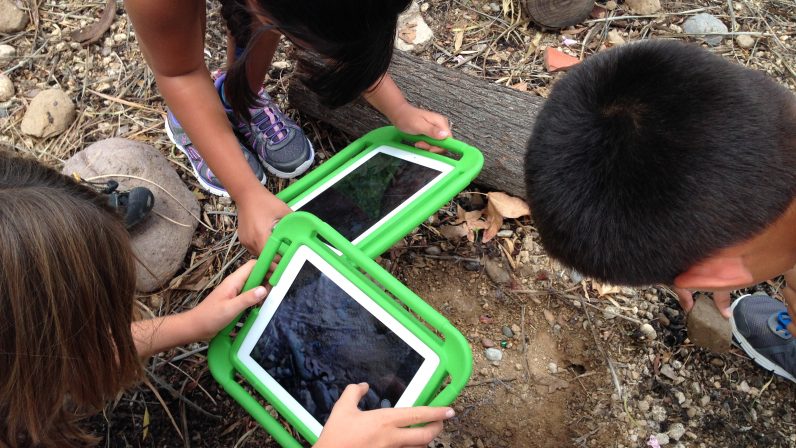One of my favorite Seed images is retired keyboards in the outdoor classrooms with dirt balls nearby. I love the side by side juxtaposition of technology and mud. In fact, when asked, I often say the Seed specializes in dirt and technology (quickly adding creativity, kindness, instilling a passion for learning). I first said the “mud and technology” comment half jokingly during a new parent tour and it seems to have stuck. I think it’s a great metaphor for what we’ve always tried to do at the Seed—keep our hands touching the earth while maintaining one foot on the cutting edge of new ideas and technology.
On Friday I was hanging out with the 3rd/4th graders and was privy to an innovative “mud and technology” learning experience. The kids worked in teams to look for creatures in the outdoor environment. Each team had an iPad and they searched the dirt and rocks for signs of wildlife to photograph. The photos were downloaded to Project Noah (http://www.projectnoah.org), “a tool to explore and document wildlife and a platform to harness the power of citizen scientists everywhere.” People from all over the world participate and in addition to helping kids identify unknown living creatures, they learn facts, add questions and share what they know. It’s an exciting way to connect technology with the natural world.
While snooping around with iPads in hand, we made an interesting discovery. Near Gwen’s Castle, a child noticed what appeared to be a pile of animal feces. “Poop. Yuck!” Taking a closer look, in the vicinity we found three slightly bloody rabbit feet, a furry white tail, and a grayish mass with green matter inside. Once everyone who saw it got over the shock and disgust of finding random rabbit parts on the Seed playground, the questions started. “What killed the rabbit?” “Where is the rest of it?” Several children expressed how sad it was that the rabbit died this way. I reminded them of the whole prey/predator cycle and that it’s the way of nature.
Over the weekend I thought about the rabbit, the poetry we’re just beginning to write, the emergent curriculum, and our emphasis this year on innovation. As I prepared for my poetry lesson today, the rabbit again came to mind. I chose questions poems to read to the kids and talked about questions as a way to write poetry. Thinking of the rabbit, we brainstormed a list of questions:
• What animal ate the bunny?
• What was the bunny doing before the attack?
• What type of bunny was it?
• Was it the same bunny Erick saw?
• Where was the rest of the bunny?
• Was it killed in the day or night?
• How did the bunny get in the school[yard]?
These questions could lead us in a variety of directions, some factual and others pure speculation. We may not answer all or any of them, but one thing for certain, the practice of asking questions will guide our studies throughout the year. For questions open doors, and it’s likely when our students open the door to the outside world their experiences with both mud and technology will serve them well.


Our playground has been home to a rabbit for about five years. It has hidden during the day in the drain pipe along the west wall near the south outdoor classrooms. The rabbit munched on grass and various goodies in the class gardens.
Saturday and Sunday are the days many carnivorous prey visit our playground. I have seen coyotes, hawks, owls, eagles, and large very mean cats. Any one of the mentioned could be responsible. I am just amazed the rabbit lived so long.
I am remembering when the highlight of the week (1977-1978) was mud and sand day, when the SEED was in its infancy. Granted the “mud and sand day was not technology, but it really promoted creativity, cooperation, and even textures.